Whole Wheat Sourdough Sandwich Bread
Whole Wheat Sourdough Sandwich Bread tastes fantastic and will keep fresh for several days. Milk and honey give this loaf a soft crumb and crust. Sourdough starter enhances the hearty whole-grain flavor.
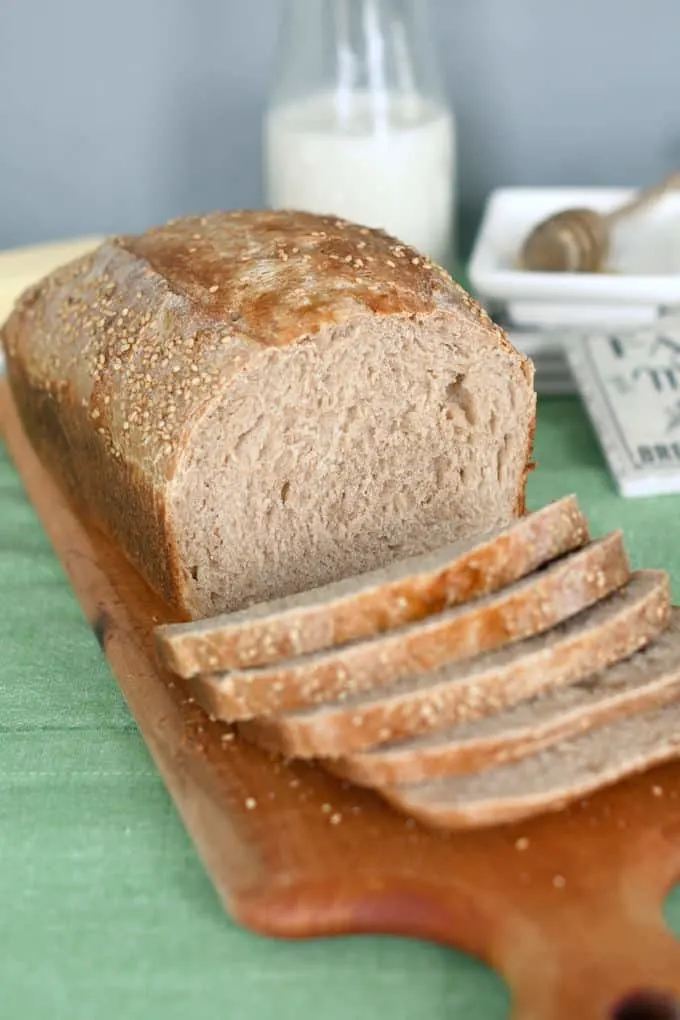
Table of contents
Why you’ll love this recipe
This recipe is a variation of my popular Milk & Honey Whole Wheat Bread recipe. This is a perfectly soft and slightly sweet sandwich bread.
Although this sourdough wheat bread recipe takes a good 12+ hours from start to finish, the vast majority of the time is hands off.
To make this recipe even more convenient, you can let the dough rise over night. A long rise in the refrigerator does only good things for the bread.
If you don’t have one, check out my post to learn How to Make a Sourdough Starter. Then check out my system to Feed and Maintain Sourdough Starter.
Ingredients
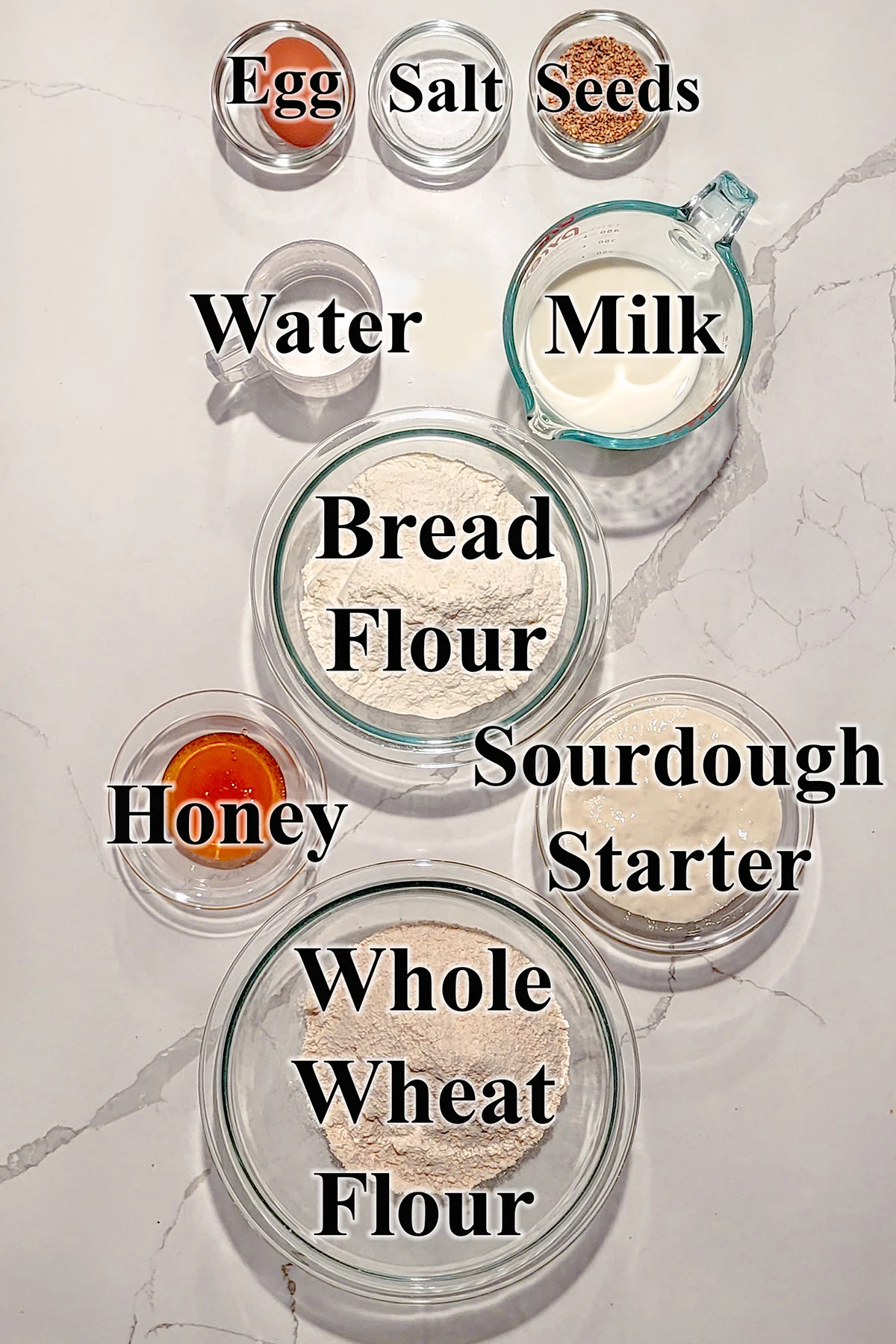
Ingredient Notes
- Sourdough Starter – This recipe was developed using 100% hydration starter. You will need to adjust the liquid or flour in the recipe if you’re starter isn’t at 100% hydration.
- Bread Flour has a high protein content. Higher protein means better gluten development.
- Whole Wheat Flour does not have quite as much of the gluten forming properties of bread flour. Using a combination of whole wheat and bread flour makes a loaf that has great whole grain flavor, yet rises tall in the oven. You can adjust the proportion of wheat vs. bread flour to make a loaf to your liking.
- Milk – Scalding denatures (breaks down) proteins in the milk which can interfere with gluten development.
- Honey – Adds wonderful flavor, enhances browning and makes the crumb soft and slightly sweet.
- Salt – For flavor.
- Sesame Seeds – For crunch and flavor on the crust.
How to make Whole Wheat Sourdough Sandwich Bread
See the recipe card for detailed measurements and instructions.
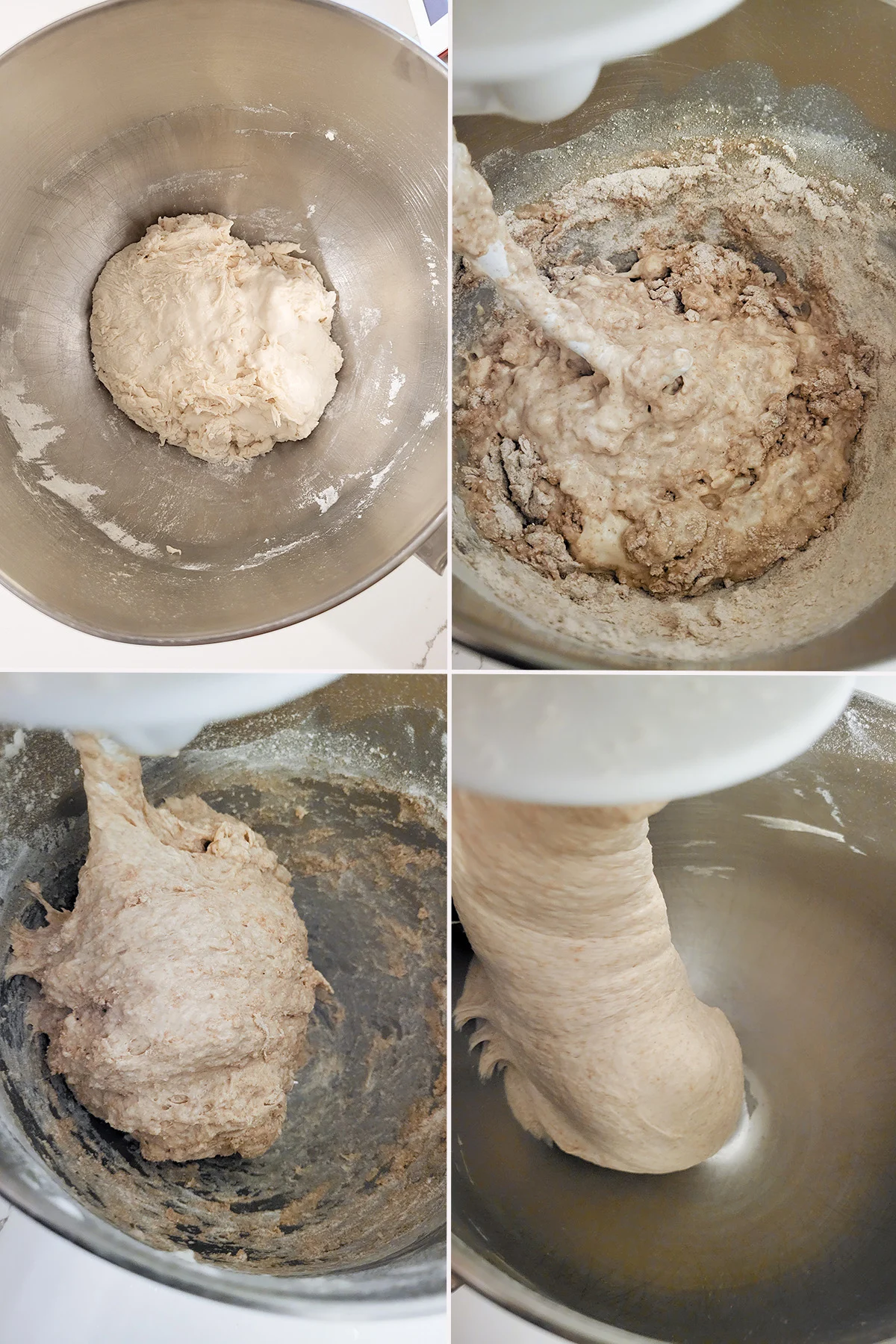
- Combine the starter, water and 1 cup of the bread flour to form a thick batter. Cover the bowl and set the mixture aside for 30-60 minutes.
- Add the rest of the ingredients.
- The dough will start out quite rough and sticky.
- Continue kneading until the dough begins to gather on the hook and pulls away from the sides of the bowl. Place the dough in an oiled bowl, turning once to coat the dough. Cover and set aside in a warm spot.
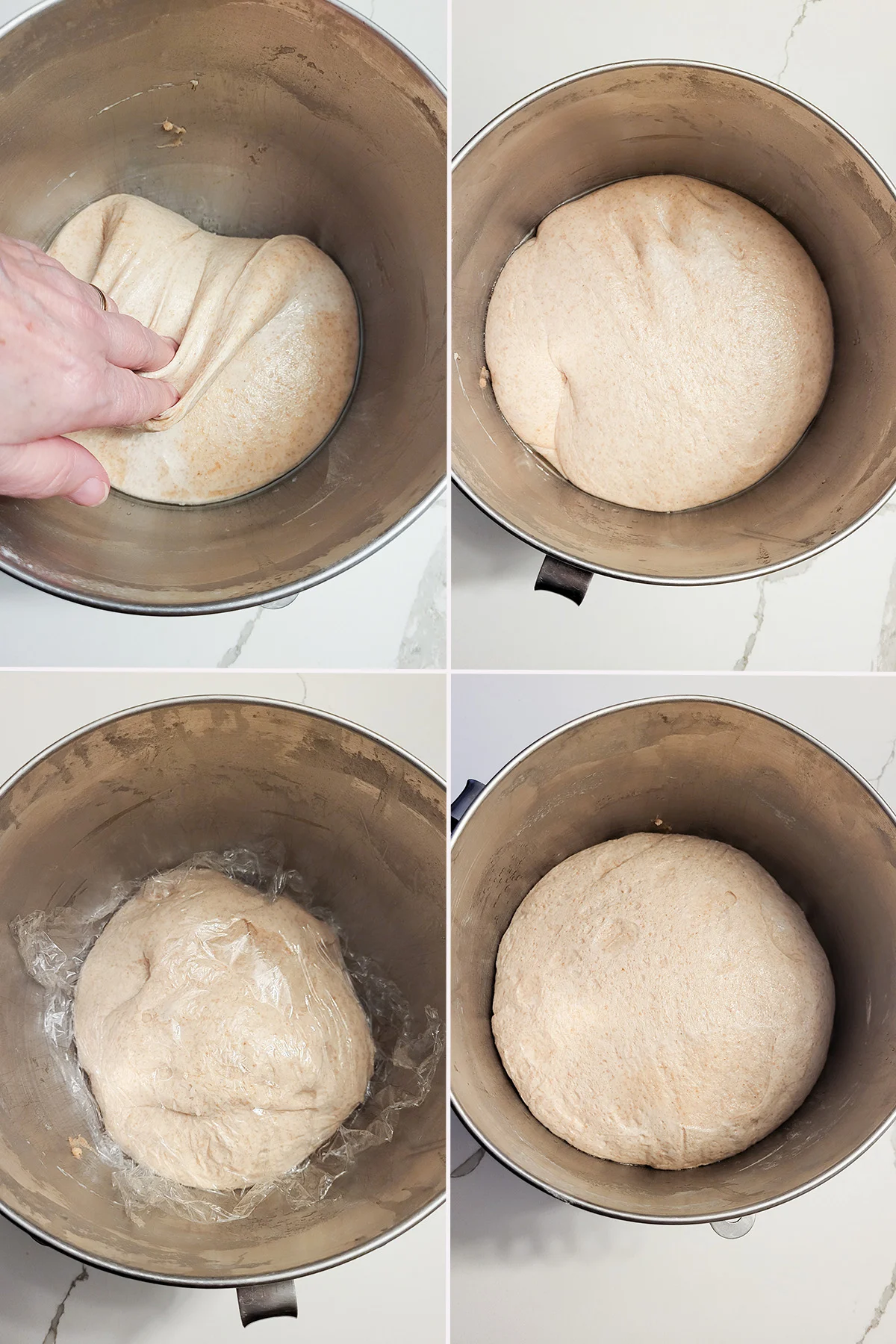
- After 30 minute, lift one side of the dough and fold it into the middle of the dough. Repeat with the other three sides of the dough then flip the dough over.
- Fold the dough every hour. After 3 hours the dough should be lively, elastic and airy.
- Cover the bowl tightly and refrigerate overnight. (If you prefer you can skip the refrigeration step and continue shaping the loaf right after the initial fermentation.)
- The next morning continue with shaping.
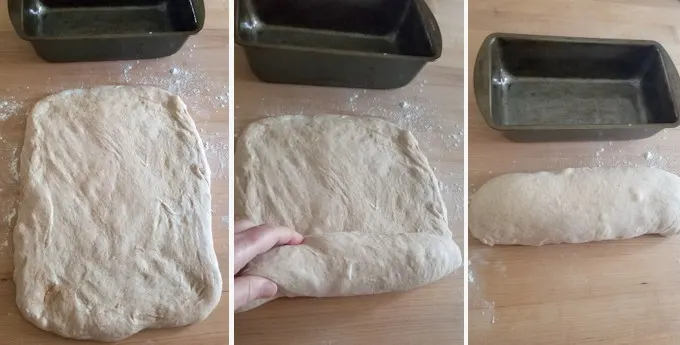
- Without kneading, use your hands to pat the dough into a rectangle.
- Roll the dough to a log.
- Set it into a lightly greased loaf pan
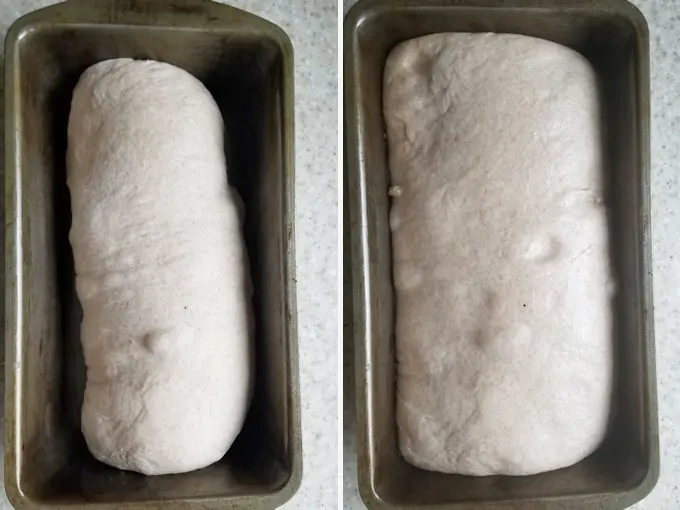
- Cover the pan and set it aside for 1 1/2 – 2 hours.
- The loaf will rise to fill up the loaf pan.
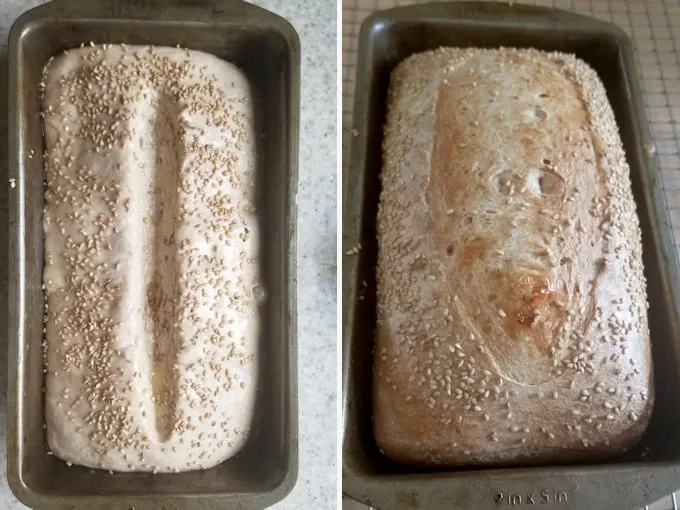
- Cut a slash down the center of the loaf. Brush with egg wash and sprinkle with sesame seeds (optional).
- Bake until the interior is 200F.
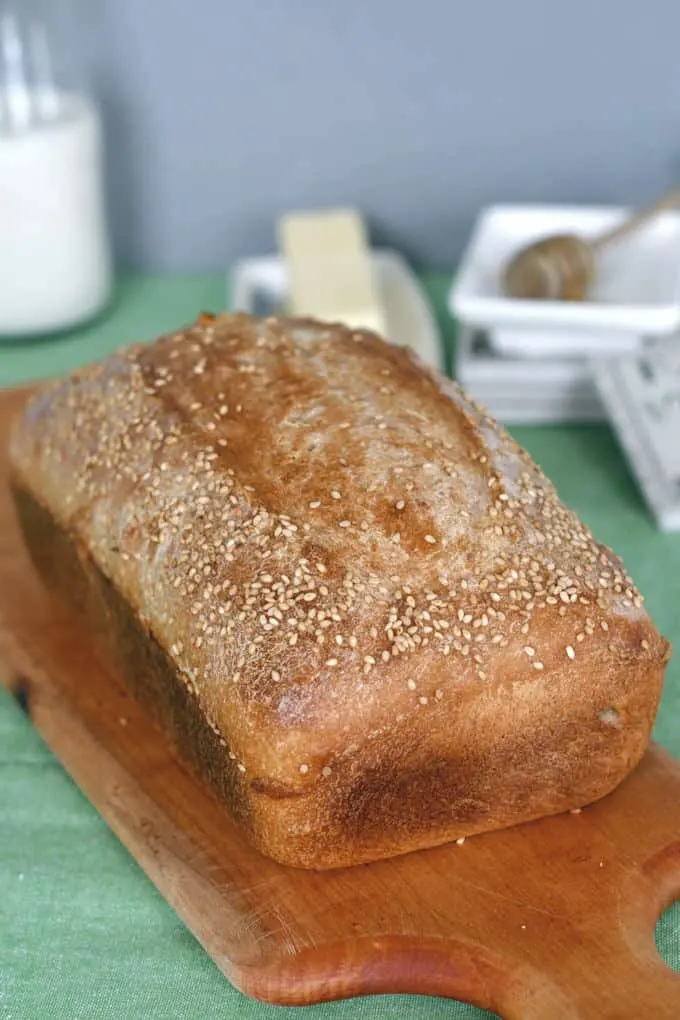
A timeline for making this recipe
- If your starter needs feeding, do that the night before or early in the morning of the day you want to make the dough.
- Mix the dough in the afternoon, allow it to ferment for 3-6 hours then refrigerate the dough before going to bed.
- Take the dough out of the refrigerator first thing in the morning, shape the loaf and set it into the pan.
- Leave the loaf to rise for 1 1/2- 2 hours, or as long as is needed to almost double in size.
- To make and bake the dough in the same day, feed your starter the evening before so it’s active by morning. Start the dough early in the morning and it should be ready to bake by late afternoon or early evening.
Storage
Sourdough Whole Wheat Bread stays fresh at room temperature for 2-3 days. The bread (sliced or whole) can be frozen for up to a month.
I know you hate to throw away that sourdough discard. Check out these recipes that use sourdough discard.
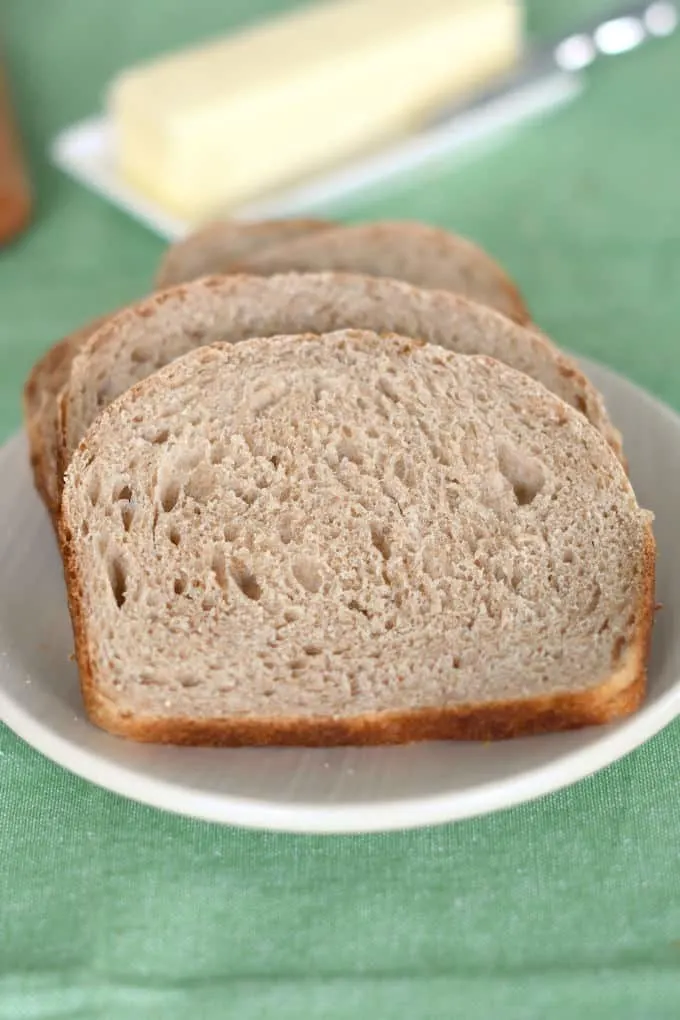
If you love this recipe as much as I do, I’d really appreciate a star rating and a quick comment. Ratings and comments help my recipes show in search results. Thanks!
Whole Wheat Sourdough Sandwich Bread
Ingredients
- 8 ounces active sourdough starter (1 cup (100% hydration))
- 4 ounces warm water (½ cup)
- 10 ounces bread flour (2 cups, see note)
- 8 ounces whole milk (1 cup)
- 1 ½ ounces honey (2 tablespoons)
- 1 ½ teaspoons table salt
- 7 ½ ounces whole wheat flour (1 ½ cups)
- 1 egg for egg wash
- Sesame seeds for garnish (optional)
Instructions
- In the bowl of a stand mixer or in a large mixing bowl, combine 8 ounces active sourdough starter, 4 ounces warm water and 1 cup (5 oz) of the bread flour to form a thick batter. Cover the bowl and allow the mixture to rise for 30-60 minutes. Warm 8 ounces whole milk until scalding hot then set it aside to cool until it is slightly warmer than body temperature.
- Add the scalded milk, 1 ½ ounces honey and 1 ½ teaspoons table salt to the sponge. Stir to combine. Add 7 ½ ounces whole wheat flourand stir until the batter looks like thick pancake batter. If using a stand mixer, switch to the dough hook.
- With the mixer running, slowly add the remaining bread flour. Continue mixing until the dough begins to gather on the hook and pulls away from the sides of the bowl. Knead for 5 minutes. If mixing by hand, add as much of the flour as you can in the bowl then finish kneading in the rest of the flour by hand.
- Dump the dough onto a lightly floured surface. The dough should be soft and slightly sticky. Knead to form a smooth ball. If the dough is very sticky sprinkle a little more flour as you knead. Place the dough in an oiled bowl, turning once to coat the dough. Cover and set aside in a warm spot.
- After 30 minutes uncover the bowl, lift one side of the dough and fold it into the middle of the dough. Repeat with the other three sides of the dough then flip the dough over. You're basically turning the dough inside-out to redistribute the yeast and strengthen the gluten. Cover the bowl and after 60 minutes repeat the procedure again.
- Cover the bowl and after 60 minutes fold the dough one more time. By now the dough should be lively, elastic and airy. If the dough is still sluggish give it another hour or two at room temperature. If you want to finish making the bread in the morning cover tightly and refrigerate overnight. The next morning continue with shaping. Otherwise continue shaping the loaf on the same day.
- Turn the dough out onto a floured surface. Without kneading out the air, gently push the dough to a 9"x 12” rectangle. Tightly roll the dough from top to bottom to form a log shape. As you roll pinch the ends of the dough to form a tight roll.
- Grease a 9"x 5" loaf pan with a very light film of vegetable oil or with baking spray. Set the dough into the pan and cover with oiled plastic wrap. Set in a warm place to rise until the dough almost doubles in size, about 1 ½ hours. It will take longer to rise if the dough is cold from a night in the refrigerator. In the meantime, preheat the oven to 350 °F.
- Use a sharp knife or razor to cut a 1/2" deep slash down the center of the loaf. Brush the dough with egg wash and sprinkle with seeds.
- Bake about 35-40 minutes until golden brown and and a toothpick inserted in the center comes out clean. The interior temp should be about 200 °F.
- Cool in the pan about 5 minutes before turning out onto a cooling rack. Cool to room temperature before slicing.
Would you like to save this recipe?
As an Amazon Associate and member of other affiliate programs, I earn from qualifying purchases.

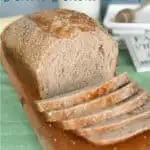
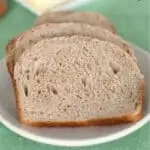
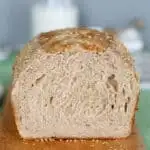





Could you use AP flour instead of bread flour for this recipe?
You could, the dough will be a little softer and wetter since bread flour will absorb more water than ap flour. You might just need to sprinkle in a little extra ap flour.
How do I double this recipe?
You can double the ingredients to make two loaves. Just makes sure if you’re using a mixer the mixer can handle that amount of dough. Otherwise, you should mix and knead by hand.
Hi Eileen
I made a huge success on making this bread! It was so lovely! Question, can I add seeds like, pumpkin, linseed, etc to the dough? Thank you!
Yes. I usually knead in seeds just before shaping the loaf. Also, don’t overdo the amount of seeds or the dough might be too heavy to rise well. You can also sprinkle some seeds on top for a crunchy crust.
I followed your instructions by putting the seeds before shaping and I also sprinkle on top. This is our weekly bread! Thank you! Question, can I use bigger loaf pan for this recipe? I have a spare 4-1/2″×10-1/2″ loaf pan. Thanks.
You can use a bigger pan. Obviously the loaf won’t be as high and it will probably bake faster since the dough will be spread out more in the pan.
How do you do this without deflating the dough?
I think I need a more specific question before I can answer. At what point did the dough deflate?
What temp do you bake?
350F.
wonderful crust, texture and taste. Thoroughly moreish!
Hi Eileen,
Would this work with wholemeal spelt flour instead of the whole wheat flour.
Thanks Carol.
Yes!
When do you add step #2?
Never mind I figured step #1 was the sponge
After allowing the sponge to rise for 30-60 minutes you continue with step 2.